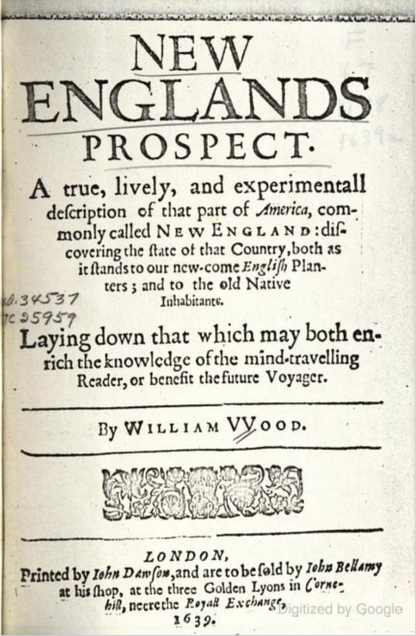William Wood, New Englands prospect: A true, lively, and experimental description of that part of America, commonly called New England: discovering the state of that countrie, both as it stands to our new-come English planters, and to the old native inhabitants (London: Thomas Cotes, 1634)

Peyton Coel and Cameron Close
After arriving in New England to start a new life, the English settlers came face-to-face with the land’s initial inhabitants: the Native Americans. The two groups suddenly had to live alongside each other, even though they were very different and often didn’t understand each other’s cultures. William Wood, an English colonist, captured these interactions, along with various differences in the land, in his book entitled New England’s Prospect, which was published and distributed across English audiences in 1634. In his writing, Wood compared and contrasted English and Native American land and society in a very biased way, which led to misconceptions of the Native Americans. However, today’s readers can tell from Wood’s text that the English presence was pushing for the decline of a successful society into a wasteful and inefficient one.
Wood splits his book into two parts, with the first part discussing New England’s environment, and comparing it to England’s. He first gave a brief explanation of the climate, weather patterns, vegetation, and animal species of both locations. There were few similarities, with the majority being related to topographical features such as rivers and oceans. The two locations were far more different, with New England having a more extreme climate, unpredictable weather patterns, more vegetation, and more animal species. Because of the harsher conditions of this new setting, many settlers passed away, as they were not prepared enough to face them. The second part discussed the Native American societies and their similarities and differences to England’s. Considering aspects such as hunting and gathering methods, goods and services, government, and traditions, it became evident that the civilizations had very few similarities as well. They initially held a belief that they could benefit from each other’s differences, which were very numerous. The Native Americans perfected their hunting techniques on their own using traps and spears, while the English relied on dogs and guns to get their food. The groups valued things differently, with the Native Americans focusing more on shared resources within a community and the English on commodities. The Native American governments were centralized, while the English fell under control of a monarch. The groups had very different religious and marital traditions, and women played different roles in the society. These contrasting variables led to serious clashes later on.
Wood and the other settlers had very different expectations for their arrival in New England. They left England for various reasons, including desire for religious freedom and owning property. They had heard tales of wide-open spaces and practically unlimited resources, which appealed to them greatly. When they arrived, however, they realized they had to share the land and live alongside another society that had been there much longer. Instead of adjusting to the Native American ways of life, the English determined their lifestyle was better and forced their practices onto the land and its people, which led to a distorted viewpoint of Native American culture. Wood’s writing painted the English as saviors to Native American society, which he quickly determined to be “lazy,” “satanic,” and abusive to women. This could not have been further from the truth, as Native American “laziness,” was actually efficiency, their “satanic” practices were religious rituals, and women willingly took on working role in their communities as opposed to English women, who did domestic chores. There was no need for the Native Americans to be reformed or saved, but the English did not view it in that way.
English need to assert their society’s dominance over Native American society led to a sharp decline in the land, its resources, and Native American tradition. When the Native Americans were the sole inhabitants, they lived alongside the land. They moved their homes and crops with each season, allowing for the land they previously lived on to renew itself and its resources. The English instead lived against the land, staying in one place for their entire lives and using up all the resources in the surrounding areas. They overworked the soil, cut down many trees, and hunted many animals. This unwillingness to move forced the Native Americans to conform to the English ways of life. After dominating the land, the English looked to convert the Native Americans to Christianity, bring them into the buying and selling market, and “civilize,” them, erasing many aspects of Native American culture.
Wood’s work captured the experience of the societies living side-by-side, but also unintentionally highlighted English dominance, decline in the land, and the diminishing of Native American society. This changed New England for good.